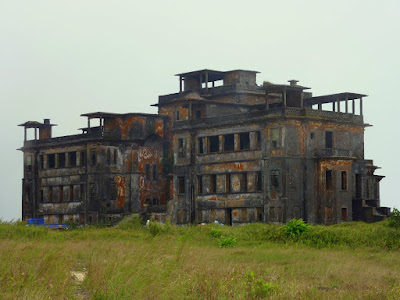Until recently, travel in Kampot province was risky, its main highways frequented by bandits. In 1994, three tourists were killed in this region by members of the Khmer Rouge. Now you're more likely to run head on with a water buffalo.
The 'VIP' bus was in fact mottled with mold – I wondered if the thing had been partially submerged in a river, pulled back into the light to dry, engine flushed and put back on the road to eke out a few more trips. Surely a mobile health hazard. Problems with the A/C meant a late departure but after a bit of jury rigging, we were off. Sort off. A couple of stops on the way meant 6 hours to travel 170 km. Most of the trip was made with the bus door left open, the french tourists onboard huffing and puffing about the heat, clambering uselessly with the vents, as if one more turn of the knob would somehow be the magic touch for that ah cool (read: slightly moldy smelling) air. We sweated while the Cambodian karaoke blasted in choppy form, thanks to a bad cd. Karaoke, like volleyball, seems to be a way of life here, and a common form of entertainment during intercity travel. I have yet to hear anyone actually perform karaoke.
(Note: the return trip we thought they were playing the beginning of an excellent recent documentary on Burma called Burma VJ, but it turned out to be a Cambodian-dubbed version of the latest Rambo, an almost unwatchable gore-fest. Another apparent form of bus entertainment: violent martial arts/police drama/war movies.)

The villas are long abandoned, shot up by the Khmer Rouge, now decaying relics under final assault from the salty sea air. For some, nature has started to reclaim old ground, with trees and vines growing through the windows of the old buildings. A few appear to have been recently renovated, but most maintain a gloriously eery look to them: windowless, doorless concrete behemoths, with stained yellow and black exteriors, surrounded by grand, albeit decaying, stone walls.
 Kep is like now similar to what it once was before the French arrived – a small fishing community. It is well known for its fresh seafood, and crab is the local speciality. Jared and I dined that evening on fresh crab with Kampot pepper, and grilled prawns with pepper lime sauce. I was converted to the delicacy of fresh crab meat, the messy ritual of shells cracked between teeth, meat sucked and slurped from knuckles and joints.
Kep is like now similar to what it once was before the French arrived – a small fishing community. It is well known for its fresh seafood, and crab is the local speciality. Jared and I dined that evening on fresh crab with Kampot pepper, and grilled prawns with pepper lime sauce. I was converted to the delicacy of fresh crab meat, the messy ritual of shells cracked between teeth, meat sucked and slurped from knuckles and joints. Locally revered for the quality of its fruits (durian, coconut, mango) Kampot province was once world famous for its fine pepper plantations, it was revered in the earlier part of the last century as the finest pepper on earth, sought after by French chefs, and beyond. At its height, Kampot was exported 8000 tonnes of the stuff annually. Production all but ceased during the Khmer Rouge years, as the plantations were abandoned or destroyed. It is being revived and now the Kampot pepper growers are seeking Protected Geographical Indication (PGI) certification (like champagne from Champagne, France, and balsamic vinegar from Modena, Italy). I had never actually seen, let alone tasted, fresh pepper, which looks like fresh green berries tightly wrapped on thin stems, and is grown on vines which take 5-7 years to reach full maturity. Fresh green pepper has a slightly sweet pepper taste, a rounder flavour than the dried pepper that we are used to. Red and white pepper all come from the same plant, and the colours are derived from the curing process.

Crossing the river are two bridges, one that reminded me of a much less dramatic version of the Eiffel-built bridge in Saint-Louis, northern Senegal. On closer inspection this rather unremarkable bridge – an aching steel and rivet structure, was clearly bombed and then rebuilt. The twisted metal of the earlier bridge still hovers just slightly above the top of the water.
Apart from a little rest and relaxation, Jared was doing a story on the Saoch, a minority group found in pockets of Cambodia and Thailand. We met with a Belgian (?) who was working with this group to build a record of their language and culture. A truly interesting character himself, he spoke 16 languages, was fluent in Khmer, and from discussions on the car ride up to the village, had a deep knowledge of local Kampot history. He has been working for several years to document the Soach language and customs and is in process of creating a rudimentary dictionary – 4000 words so far – to preserve the language. Prior to being scattered by the Khmer Rouge, they were landowners, but as they lost their land, they in turn lost their economic base. As he explained, the Saoch no longer view their language as 'having value', and the elders have more or less stopped teaching it to the younger generations. Listening to Jared interview the local heads, I felt that I was present to the very extinction of a language, and through it, a culture. Indeed, once the elders pass, the language will be gone forever, and oddly enough it will be a distant foreigner who may be the last link to preserving it.

Finally, a little taste of the Bokor mists...





Cool beans!
ReplyDelete